FPGA-Based Tactile Sensory Platform with Optical Fiber Data Link for Feedback Systems in Prosthetics
Abstract
1. Introduction
2. Review of the State-of-the-Art
3. System Architecture: Design and Implementation
3.1. The Tactile Sensors
3.2. The Data Acquisition System
3.3. The Optical Communication Link
3.4. The Electrotactile Stimulator
4. Experimental Setup and Results
5. Conclusions
Author Contributions
Funding
Conflicts of Interest
References
- Ward, K.; Pamungkas, D. Multi-channel Electro-tactile Feedback System for a Prosthetic Hand. In Mechatronics and Machine Vision in Practice 3; Billingsley, J., Brett, P., Eds.; Springer: Heidelberg, Germany, 2018; ISBN 978-3-319-76947-9. [Google Scholar]
- Liu, X.X.; Chai, G.H.; Qu, H.E.; Lan, N. A sensory feedback system for prosthetic hand based on evoked tactile sensation. In Proceedings of the 37th Annual Conference IEEE EMBC, Milan, Italy, 25–29 August 2015. [Google Scholar]
- Weiner, P.; Neef, C.; Shibata, Y.; Nakamura, Y.; Asfour, T. An Embedded, Multi-Modal Sensor System for Scalable Robotic and Prosthetic Hand Fingers. Sensors 2020, 20, 101. [Google Scholar] [CrossRef] [PubMed]
- Choi, B.; Kang, S.; Choi, H. Development of tactile sensor for detecting contact force and slip. In Proceedings of the Conference IEEE RSJ, Edmonton, Canada, 2–6 August 2005. [Google Scholar]
- Kostić, M.; Kojić, V.; Ičagić, S.; Andersson Ersman, P.; Mulla, M.Y.; Strandberg, J.; Herlogsson, L.; Keller, T.; Štrbac, M. Design and Development of OECT Logic Circuits for Electrical Stimulation Applications. Appl. Sci. 2022, 12, 3985. [Google Scholar] [CrossRef]
- Lee, H.-K.; Chang, S.-I.; Yoon, E. A Flexible Polymer Tactile Sensor: Fabrication and Modular Expandability for Large Area Deployment. J. Microelectromechanical Syst. 2006, 15, 1681–1686. [Google Scholar] [CrossRef]
- Weiss, K.; Worn, H. Resistive tactile sensor matrices using inter-electrode sampling. In Proceedings of the Conference IEEE IECON, Raleigh, NC, USA, 6–10 November 2005. [Google Scholar]
- Peng, Y.; Yang, N.; Xu, Q.; Dai, Y.; Wang, Z. Recent Advances in Flexible Tactile Sensors for Intelligent Systems. Sensors 2021, 21, 5392. [Google Scholar] [CrossRef] [PubMed]
- Capineri, L.; Bulletti, A. A Versatile Analog Electronic Interface for Piezoelectric Sensors Used for Impacts Detection and Positioning in Structural Health Monitoring (SHM) Systems. Electronics 2021, 10, 1047. [Google Scholar] [CrossRef]
- Pohtongkam, S.; Srinonchat, J. Tactile Object Recognition for Humanoid Robots Using New Designed Piezoresistive Tactile Sensor and DCNN. Sensors 2021, 21, 6024. [Google Scholar] [CrossRef] [PubMed]
- Bulić, P.; Kojek, G.; Biasizzo, A. Data Transmission Efficiency in Bluetooth Low Energy Versions. Sensors 2019, 19, 3746. [Google Scholar] [CrossRef] [PubMed]
- Mikhaylov, K.; Tervonen, J. Evaluation of Power Efficiency for Digital Serial Interfaces of Microcontrollers. In Proceedings of the Conference IEEE NTMS, Istanbul, Turkey, 7–10 May 2012. [Google Scholar]
- De Marcellis, A.; Di Patrizio Stanchieri, G.; Palange, E.; Faccio, M.; Constandinou, T.G. An Ultra-Wideband-Inspired Systemon-Chip for an Optical Bidirectional Transcutaneous Biotelemetry. In Proceedings of the Conference IEEE BioCAS, Cleveland, OH, USA, 17–19 October 2018. [Google Scholar]
- De Marcellis, A.; Di Patrizio Stanchieri, G.; Faccio, M.; Palange, E.; Constandinou, T. A 300 Mbps 37 pJ/bit UWB-Based Transcutaneous Optical Biotelemetry Link. IEEE Trans. BIOCAS 2020, 14, 441–451. [Google Scholar] [CrossRef] [PubMed]
- Di Patrizio Stanchieri, G.; Saleh, M.; Sciulli, M.; De Marcellis, A.; Ibrahim, A.; Valle, M.; Faccio, M.; Palange, E. FPGA-Based Tactile Sensory Feedback System with Optical Fiber Data Communication Link for Prosthetic Applications. In Proceedings of the Conference IEEE ICECS, Genoa, Italy, 27–29 November 2019. [Google Scholar]
- Bianchi, M.; Haschke, R.; Büscher, G.; Ciotti, S.; Carbonaro, N.; Tognetti, A. A Multi-Modal Sensing Glove for Human Manual-Interaction Studies. Electronics 2016, 5, 42. [Google Scholar] [CrossRef]
- Vidal-Verdú, F.; Barquero, M.J.; Castellanos-Ramos, J.; Navas-González, R.; Sánchez, J.A.; Serón, J.; García-Cerezo, A. A Large Area Tactile Sensor Patch Based on Commercial Force Sensors. Sensors 2011, 11, 5489–5507. [Google Scholar] [CrossRef] [PubMed]
- Schmitz, A.; Maiolino, P.; Maggiali, M.; Natale, L.; Cannata, G.; Metta, G. Methods and Technologies for the Implementation of Large-Scale Robot Tactile Sensors. IEEE Trans. Robot. 2011, 27, 389–400. [Google Scholar] [CrossRef]
- Huang, H.; Li, T.; Bruschini, C.; Enz, C.; Justiz, J.; Antfolk, C. Multi-modal Sensory Feedback System for Upper Limb Amputees. In Proceedings of the Conference IEEE NGCAS, Genova, Italy, 6–9 September 2017. [Google Scholar]
- Saleh, M.; Ibrahim, A.; Ansovini, F.; Mohanna, Y.; Valle, M. Low Power Electronic System for Tactile Sensory Feedback for Prosthetics. J. Low Power Electron. 2019, 15, 95–103. [Google Scholar] [CrossRef]
- Schmitz, J.A.; Sherman, J.M.; Hansen, S.; Murray, S.J.; Balkir, S.; Hoffman, M.W. A Low-Power, Single-Chip Electronic Skin Interface for Prosthetic Applications. IEEE Trans. Biomed. Circuits Syst. 2019, 13, 1186–1200. [Google Scholar] [CrossRef] [PubMed]
- Abbass, Y.; Saleh, M.; Dosen, S.; Valle, M. Embedded Electrotactile Feedback System for Hand Prostheses Using Matrix Electrode and Electronic Skin. IEEE Trans. Biomed. Circuits Syst. 2021, 15, 912–925. [Google Scholar] [CrossRef]
- Abbass, Y.; Dosen, S.; Seminara, L.; Valle, M. Full-hand electrotactile feedback using electronic skin and matrix electrodes for high-bandwidth human-machine interfacing. Philos. Trans. R. Soc. A Math. Phys. Eng. Sci. 2022, 380, 2228. [Google Scholar] [CrossRef]
- Javan-Khoshkholgh, A.; Farajidavar, A. An Implantable Inductive Near-Field Communication System with 64 Channels for Acquisition of Gastrointestinal Bioelectrical Activity. Sensors 2019, 19, 2810. [Google Scholar] [CrossRef] [PubMed]
- Stoecklin, S.; Rosch, E.; Yousaf, A.; Reindl, L. Very High Bit Rate Near Field Communication with Low-Interference Coils and Digital Single-Bit Sampling Transceivers for Biomedical Sensor Systems. Sensors 2020, 21, 6025. [Google Scholar] [CrossRef] [PubMed]
- Seminara, L.; Capurro, M.; Cirillo, P.; Cannata, G.; Valle, M. Electromechanical characterization of piezoelectric PVDF polymer films for tactile sensors in robotics applications. Sens. Actuators A Phys. 2011, 169, 49–58. [Google Scholar] [CrossRef]
- Zirkl, M.; Sawatdee, A.; Helbig, U.; Krause, M.; Scheipl, G.; Kraker, E.; Ersman, P.A.; Nilsson, D.; Platt, D.; Bodö, P.; et al. An All-Printed Ferroelectric Active Matrix Sensor Network Based on Only Five Functional Materials Forming a Touchless Control Interface. Adv. Mater. 2011, 23, 2069–2074. [Google Scholar] [CrossRef] [PubMed]
- Fares, H.; Abbass, Y.; Valle, M.; Seminara, L. Validation of Screen-Printed Electronic Skin Based on Piezoelectric Polymer Sensors. Sensors 2020, 20, 1160. [Google Scholar] [CrossRef] [PubMed]
- 32-Channel, Current-Input Analog-to-Digital Converter. Available online: www.ti.com (accessed on 2 May 2019).

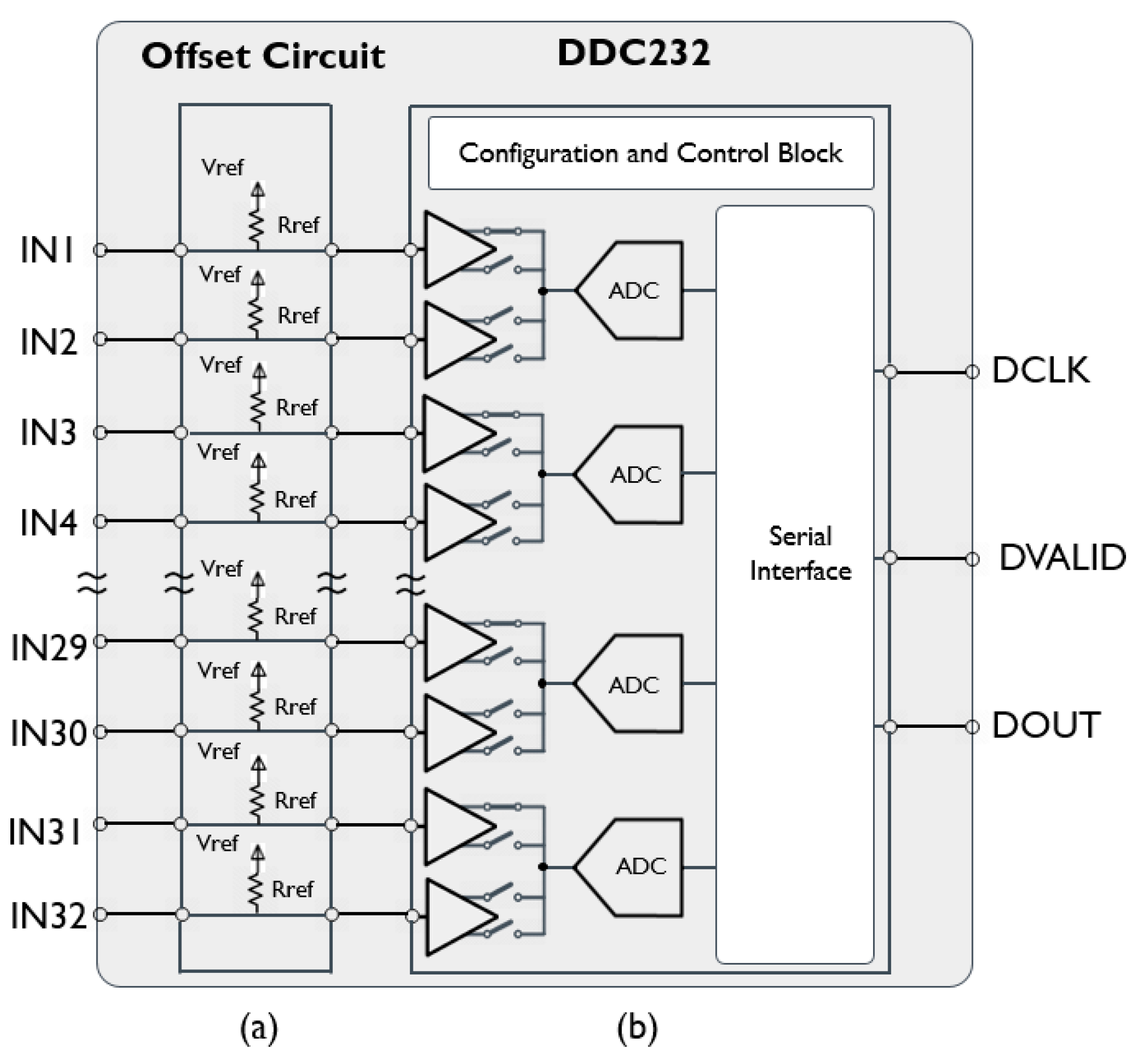
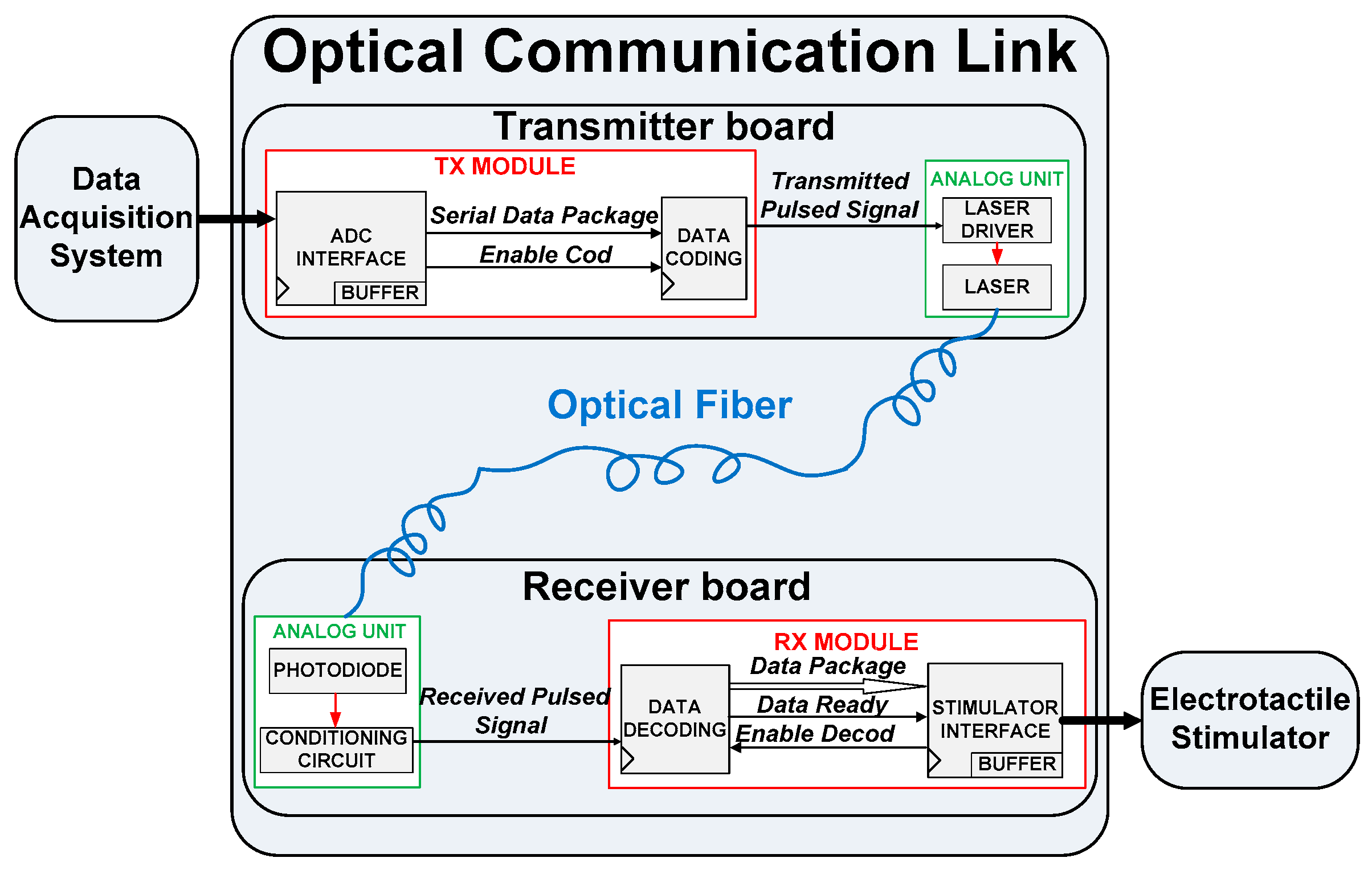
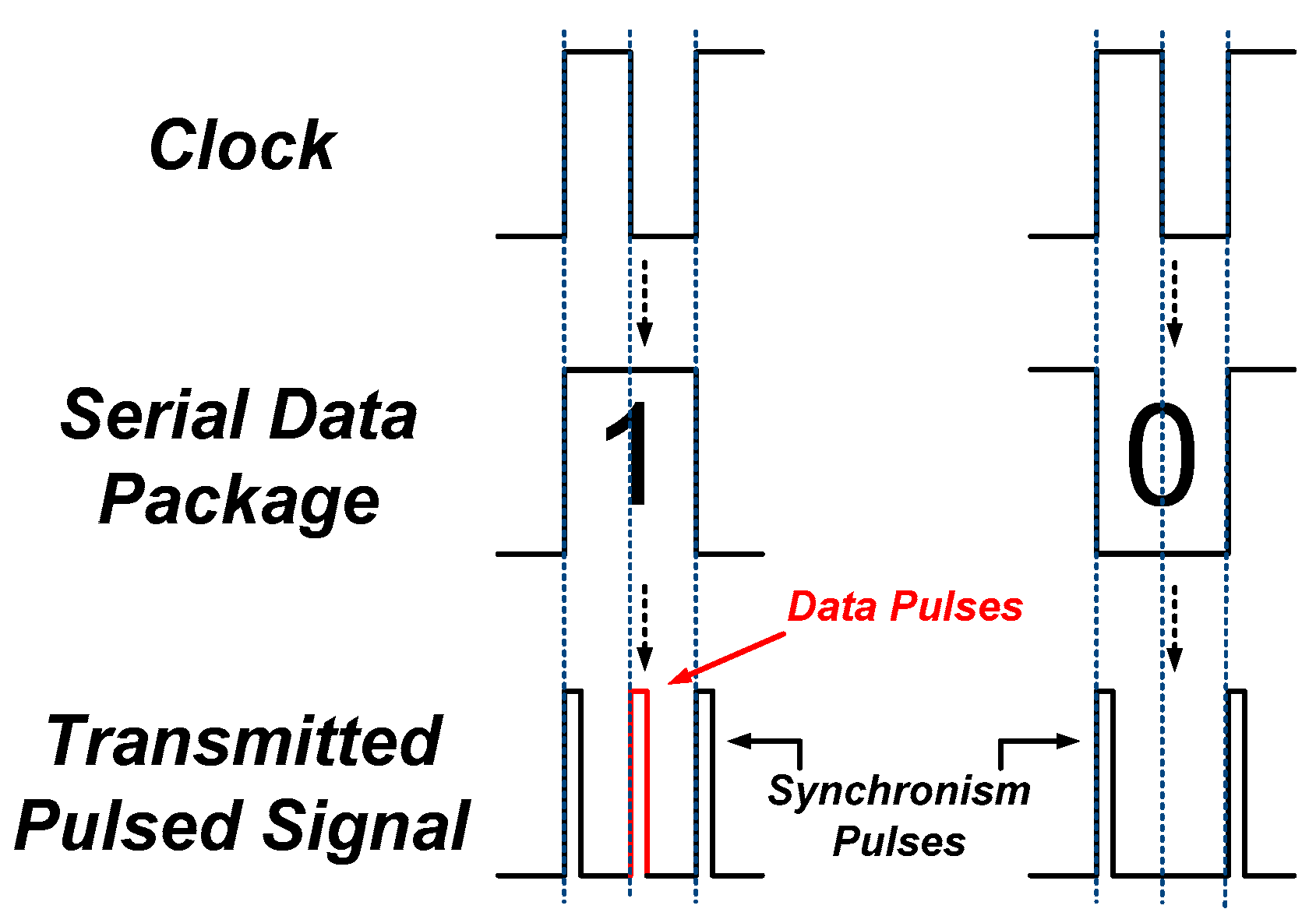
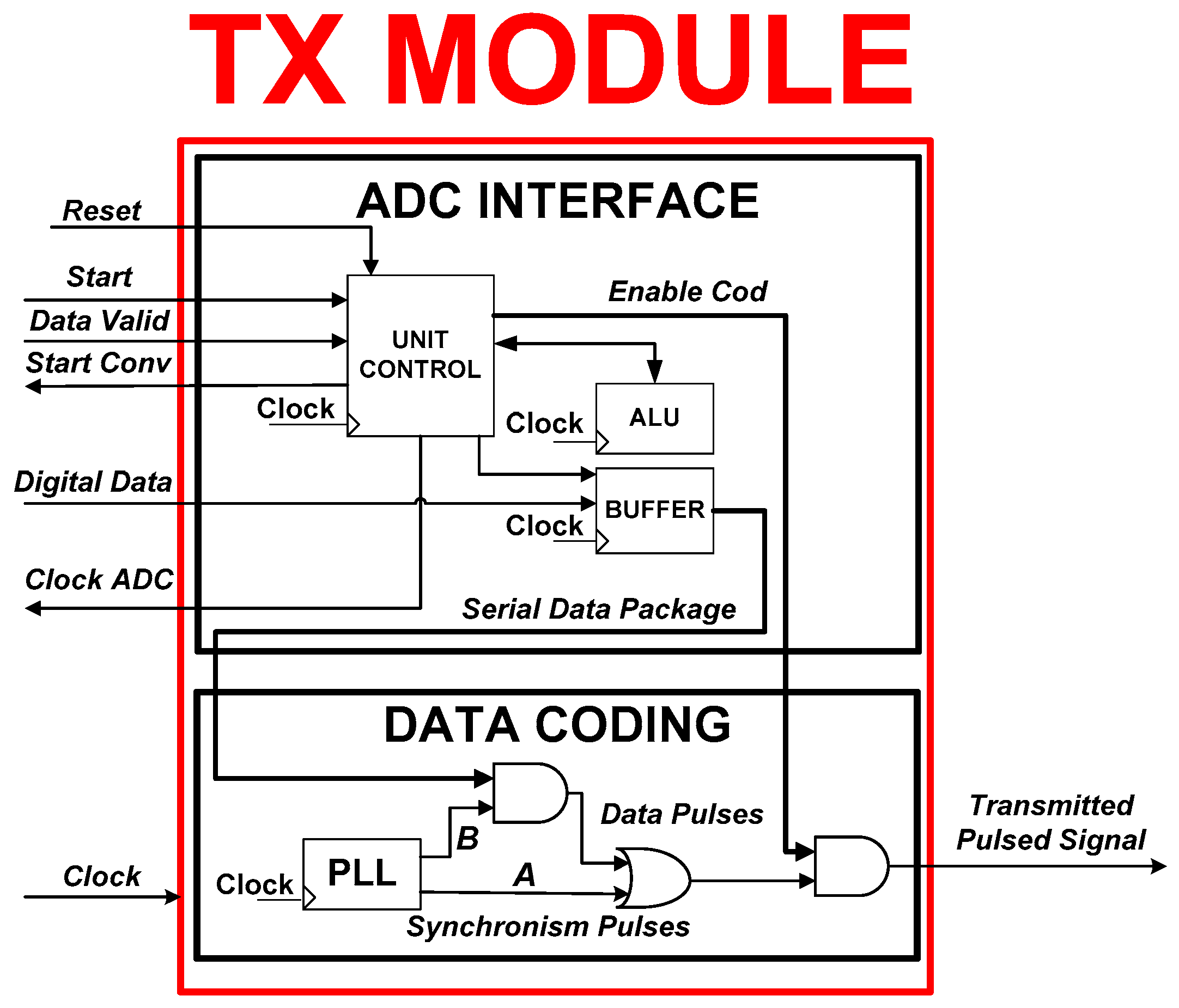

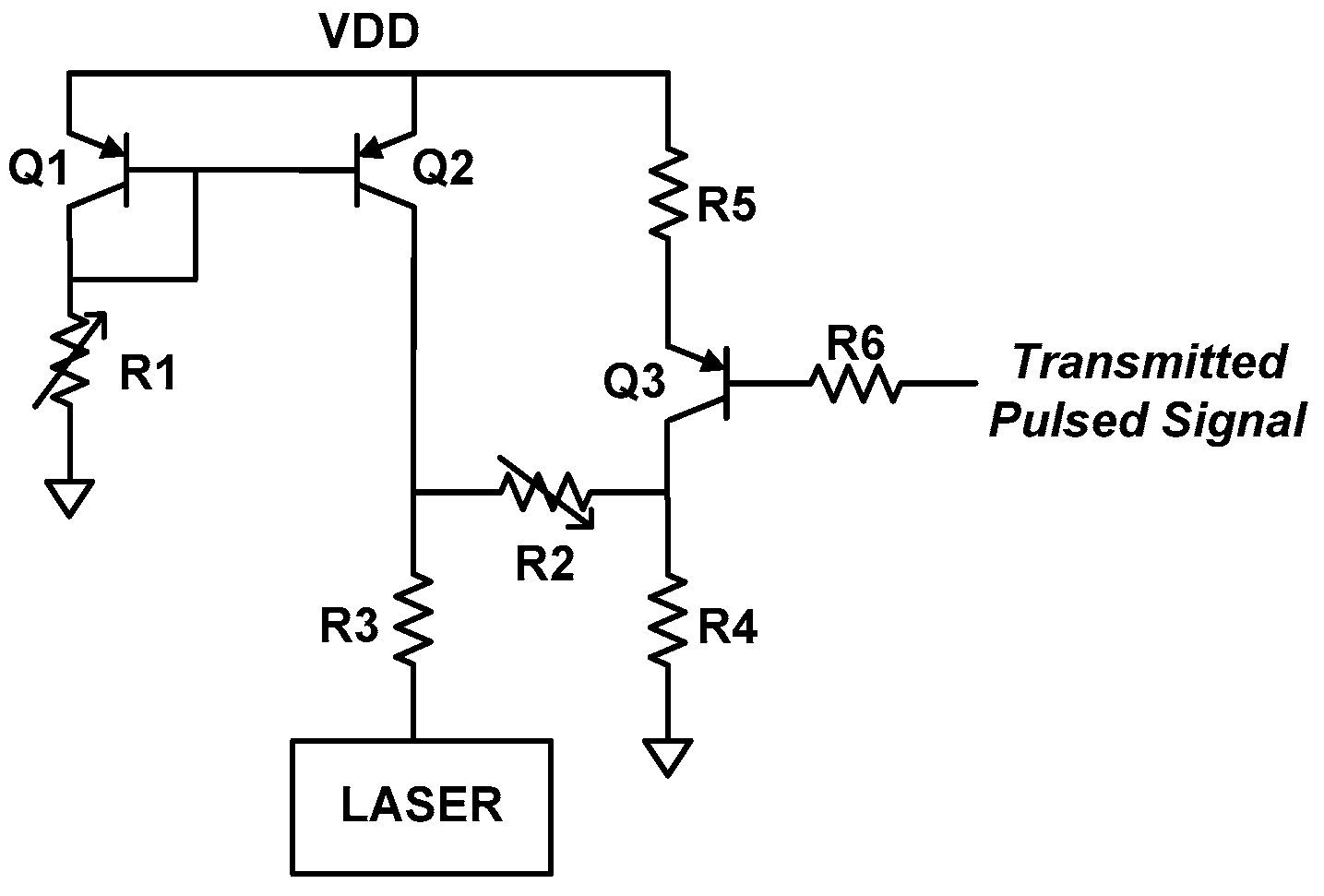
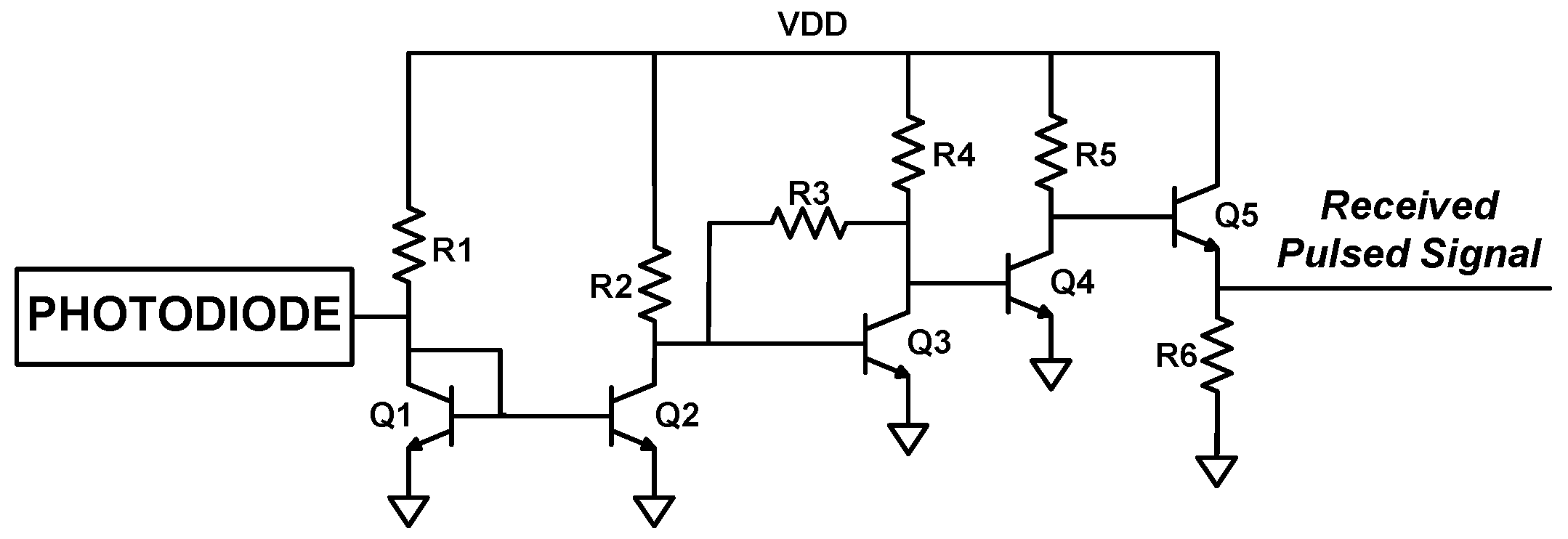
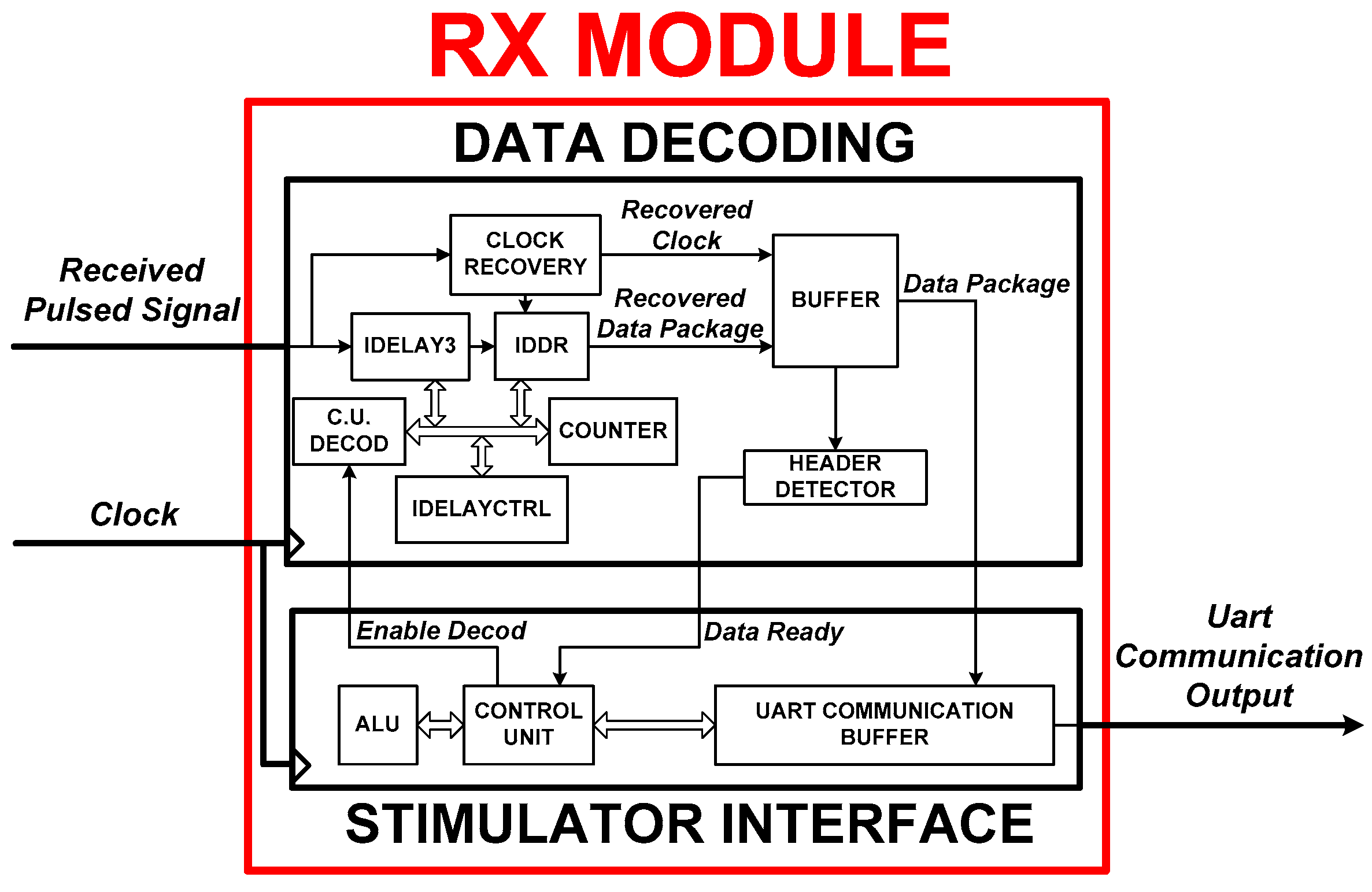

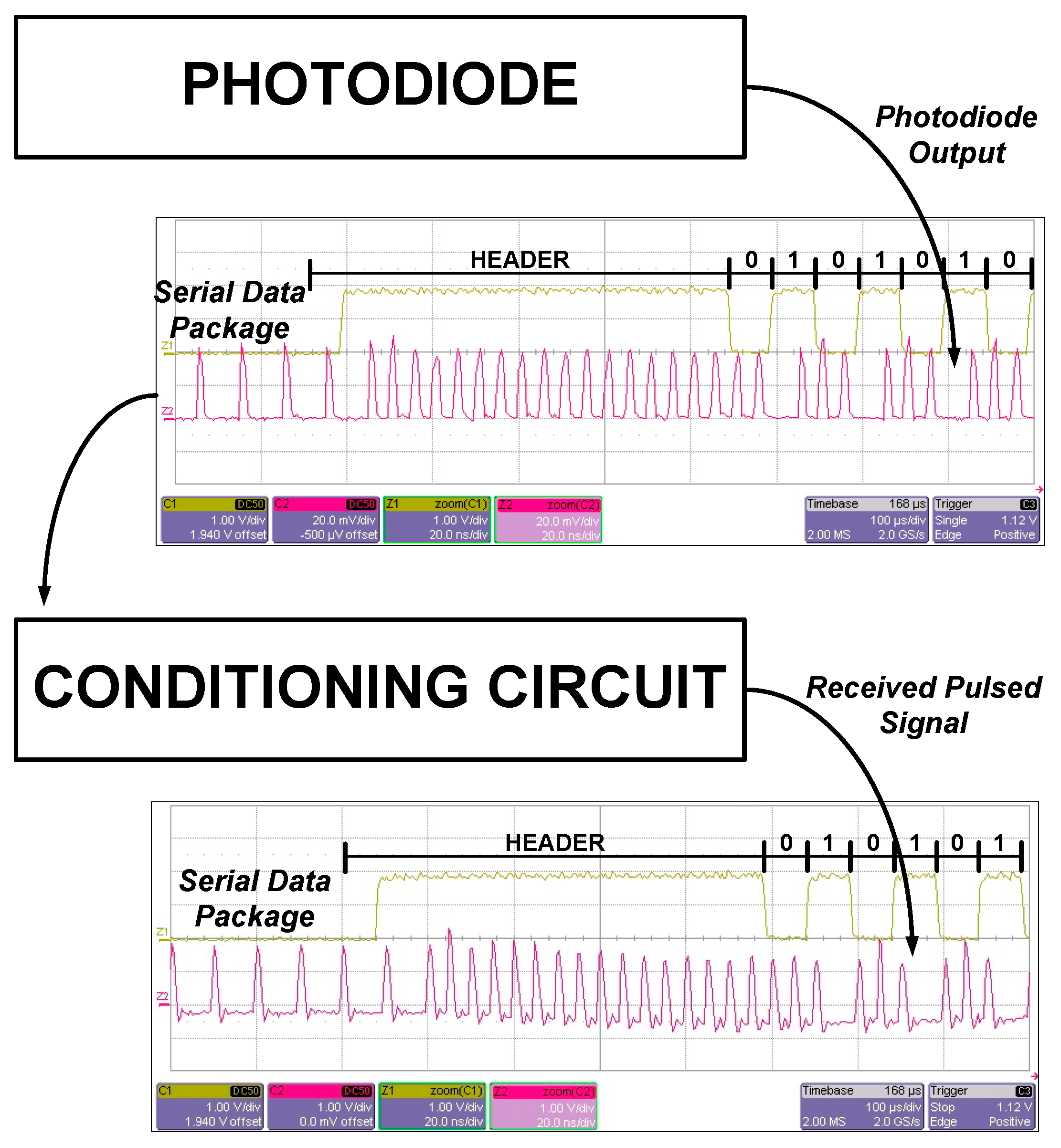
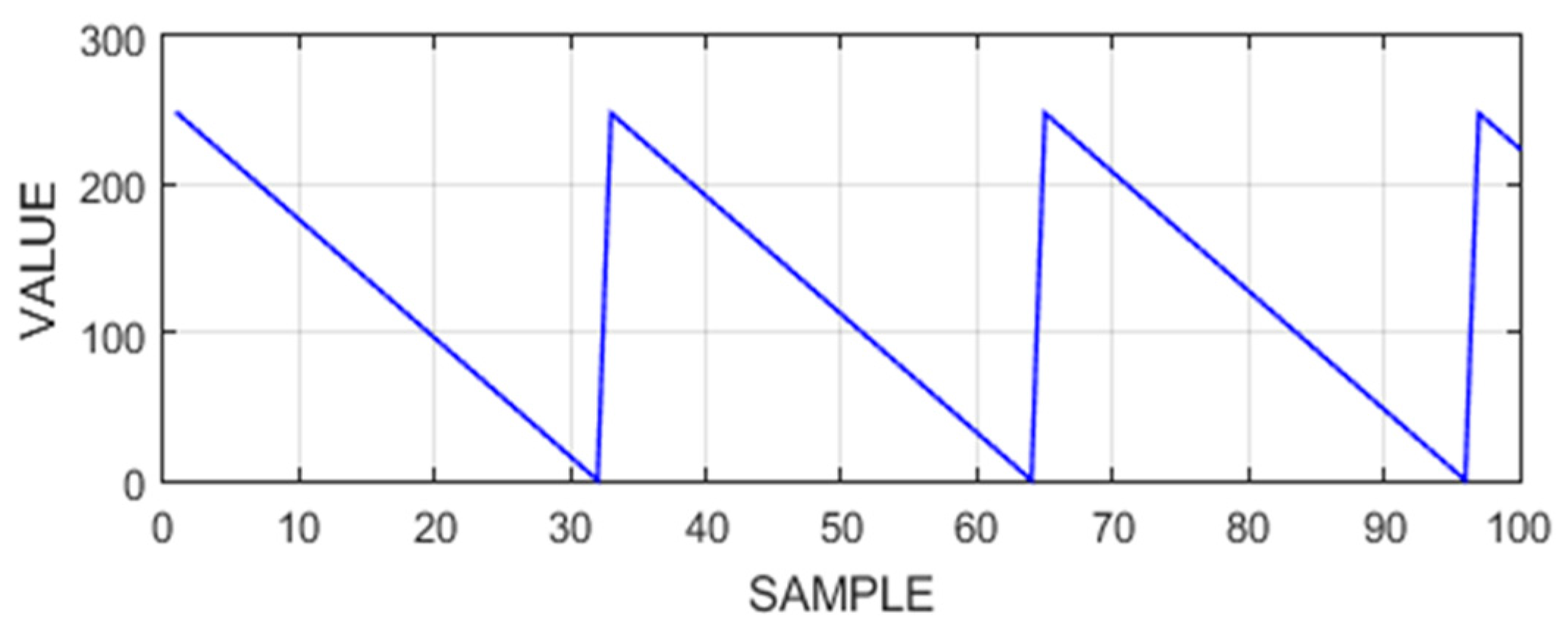
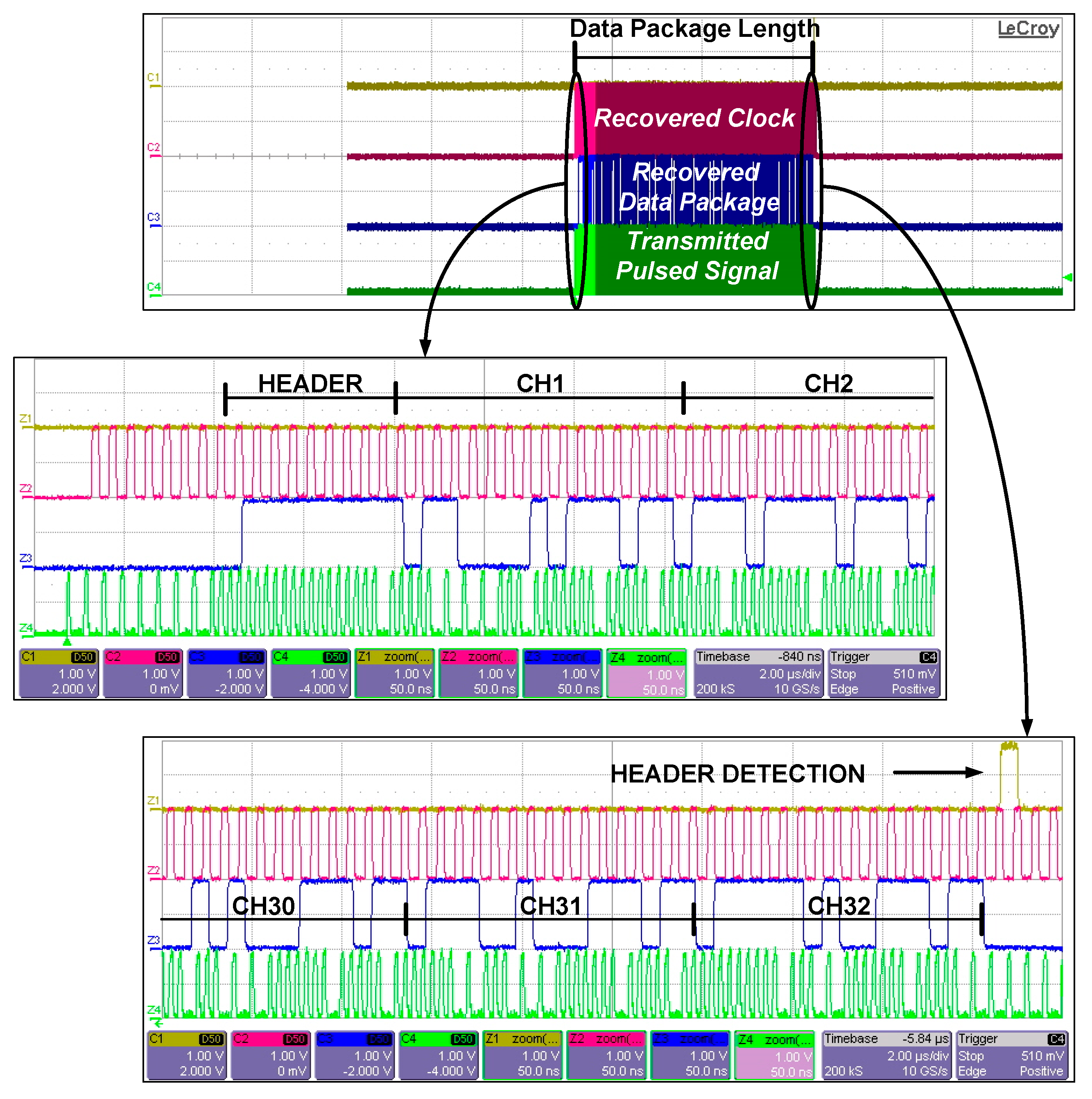
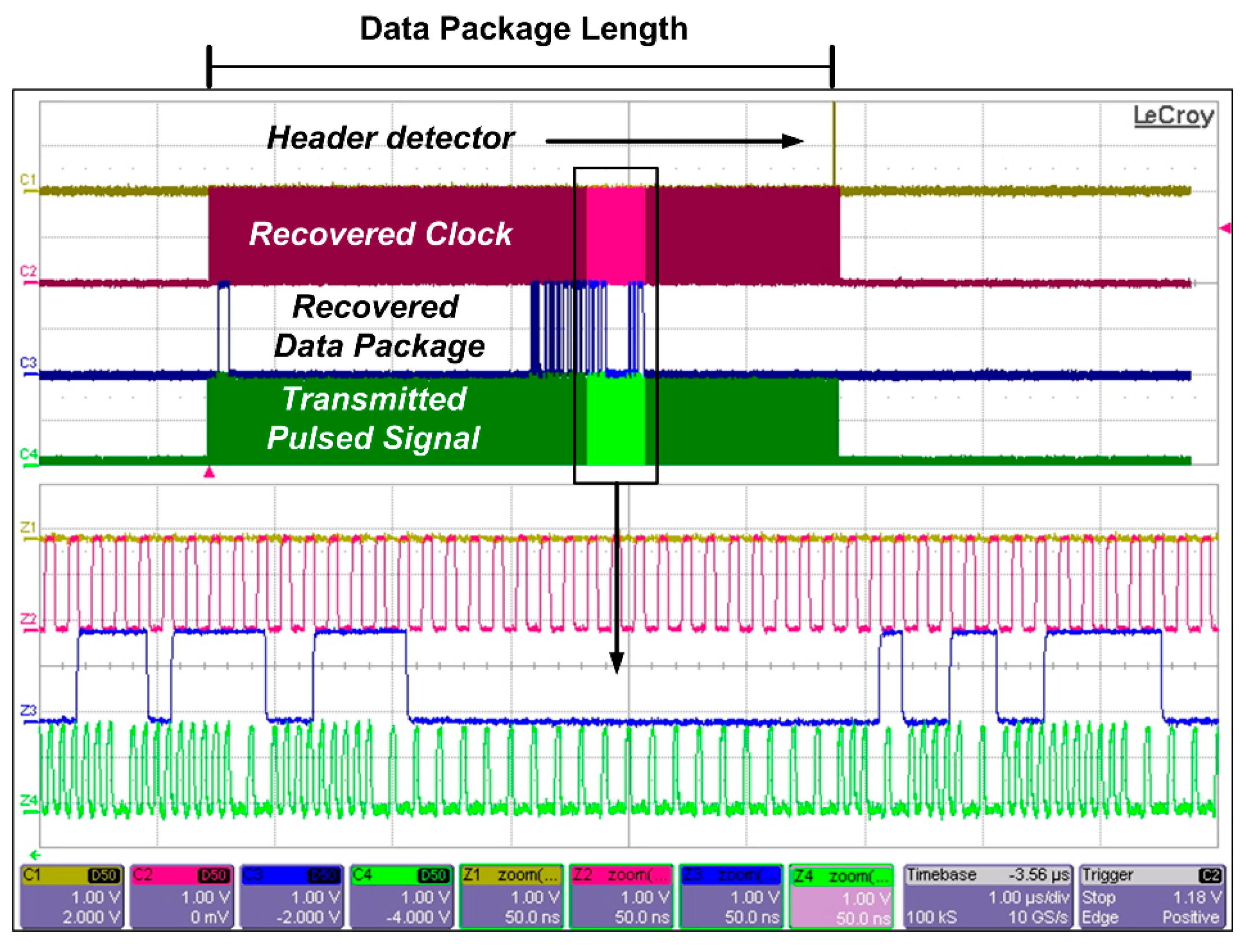
| Number of tactile sensors | 32 |
| Sensor data sampling rate | 2 kS/s |
| Optical transmission data rate | 100 Mbps |
| Optical link power consumption | 5 mW |
| Transmission power efficiency | 50 pJ/bit |
| FPGA LUTs for the Tx + Rx | 1420 + 1320 |
| FPGA FFs for the Tx + Rx | 2230 + 2860 |
| [Ref] Year | [22] 2019 | [24] 2019 | [25] 2020 | [This Work] 2023 |
|---|---|---|---|---|
| Data rate [Mbps] | 1 | 0.125 | 6.78 | 100 |
| Efficiency [pJ/bit] | 30 k | 50.4 k | 1.01 k | 50 |
| Communication link | Bluetooth | RFID | Inductive | Optical |
| Maximum operating distance [m] | <100 | 0.05 | 0.01 | 200 |
Disclaimer/Publisher’s Note: The statements, opinions and data contained in all publications are solely those of the individual author(s) and contributor(s) and not of MDPI and/or the editor(s). MDPI and/or the editor(s) disclaim responsibility for any injury to people or property resulting from any ideas, methods, instructions or products referred to in the content. |
© 2023 by the authors. Licensee MDPI, Basel, Switzerland. This article is an open access article distributed under the terms and conditions of the Creative Commons Attribution (CC BY) license (https://creativecommons.org/licenses/by/4.0/).
Share and Cite
Di Patrizio Stanchieri, G.; Saleh, M.; De Marcellis, A.; Ibrahim, A.; Faccio, M.; Valle, M.; Palange, E. FPGA-Based Tactile Sensory Platform with Optical Fiber Data Link for Feedback Systems in Prosthetics. Electronics 2023, 12, 627. https://doi.org/10.3390/electronics12030627
Di Patrizio Stanchieri G, Saleh M, De Marcellis A, Ibrahim A, Faccio M, Valle M, Palange E. FPGA-Based Tactile Sensory Platform with Optical Fiber Data Link for Feedback Systems in Prosthetics. Electronics. 2023; 12(3):627. https://doi.org/10.3390/electronics12030627
Chicago/Turabian StyleDi Patrizio Stanchieri, Guido, Moustafa Saleh, Andrea De Marcellis, Ali Ibrahim, Marco Faccio, Maurizio Valle, and Elia Palange. 2023. "FPGA-Based Tactile Sensory Platform with Optical Fiber Data Link for Feedback Systems in Prosthetics" Electronics 12, no. 3: 627. https://doi.org/10.3390/electronics12030627
APA StyleDi Patrizio Stanchieri, G., Saleh, M., De Marcellis, A., Ibrahim, A., Faccio, M., Valle, M., & Palange, E. (2023). FPGA-Based Tactile Sensory Platform with Optical Fiber Data Link for Feedback Systems in Prosthetics. Electronics, 12(3), 627. https://doi.org/10.3390/electronics12030627









